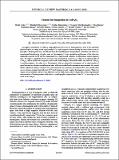Por favor, use este identificador para citar o enlazar a este item:
http://hdl.handle.net/10261/287325COMPARTIR / EXPORTAR:
 SHARE SHARE
 CORE
BASE CORE
BASE
|
|
| Visualizar otros formatos: MARC | Dublin Core | RDF | ORE | MODS | METS | DIDL | DATACITE | |

| Título: | Unusual ferrimagnetism in CaFe2O4 |
Autor: | Ueda, Hiroki; Skoropata, Elizabeth; Piamonteze, Cinthia; Ortiz Hernández, Nazaret; Burian, Max; Tanaka, Yoshikazu; Klauser, Christine; Damerio, Silvia; Noheda, Beatriz; Staub, Urs | Palabras clave: | Antiferromagnets Ferrimagnets X-ray absorption spectroscopy X-ray diffraction |
Fecha de publicación: | 8-dic-2022 | Editor: | American Physical Society | Citación: | Physical Review Materials 6(12): 124405 (2022) | Resumen: | Incomplete cancellation of collinear antiparallel spins gives rise to ferrimagnetism. Even if the oppositely polarized spins are owing to the equal number of a single magnetic element having the same valence state, in principle, a ferrimagnetic state can still arise from the crystallographic inequivalence of the host ions. However, experimental identification of such a state as "ferrimagnetic"is not straightforward because of the often tiny magnitude expected for M and the requirement for a sophisticated technique to differentiate similar magnetic sites. We report a synchrotron-based resonant x-ray investigation at the Fe L2,3 edges on an epitaxial film of CaFe2O4, which exhibits two magnetic phases with similar energies. We find that while one phase of CaFe2O4 is antiferromagnetic, the other one is ferrimagnetic with an antiparallel arrangement of an equal number of spins between two distinct crystallographic sites with very similar local coordination environments. Our results further indicate two distinct origins of an overall minute M; one is intrinsic, from distinct Fe3+ sites, and the other one is extrinsic, arising from defective Fe2+ likely forming weakly coupled ferrimagnetic clusters. These two origins are uncorrelated and have very different coercive fields. Hence, this work provides a direct experimental demonstration of ferrimagnetism solely due to crystallographic inequivalence of the Fe3+ as the origin of the weak M of CaFe2O4. | Versión del editor: | http://dx.doi.org/10.1103/PhysRevMaterials.6.124405 | URI: | http://hdl.handle.net/10261/287325 | DOI: | 10.1103/PhysRevMaterials.6.124405 | ISSN: | 2475-9953 |
| Aparece en las colecciones: | (ICMAB) Artículos |
Ficheros en este ítem:
| Fichero | Descripción | Tamaño | Formato | |
|---|---|---|---|---|
| Ueda_PhysRevMat_2023_editorial.pdf | Artículo principal | 2,76 MB | Adobe PDF |  Visualizar/Abrir |
| Ueda_PhysRevMat_2023_suppl_editorial.pdf | Información complementaria | 500,32 kB | Adobe PDF |  Visualizar/Abrir |
CORE Recommender
Page view(s)
43
checked on 22-abr-2024
Download(s)
40
checked on 22-abr-2024
Google ScholarTM
Check
Altmetric
Altmetric
NOTA: Los ítems de Digital.CSIC están protegidos por copyright, con todos los derechos reservados, a menos que se indique lo contrario.
